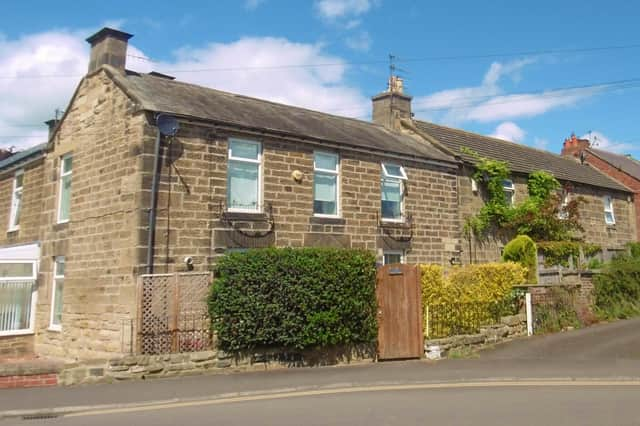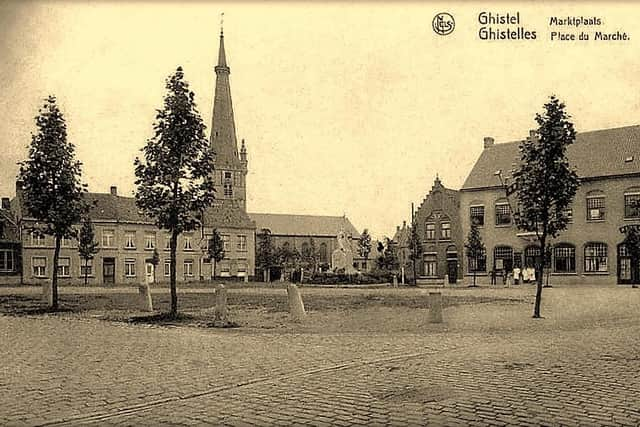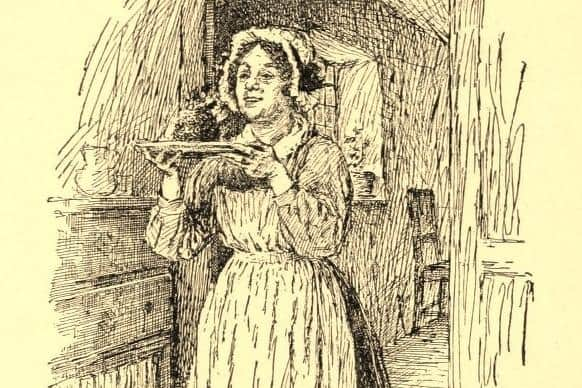Morpathia: An English Christmas in Belgium, 1843


“And now two smaller Cratchits, boy and girl, came tearing in, screaming that outside the baker’s they had smelt the goose, and known it for their own; and basking in luxurious thoughts of sage-and-onions, these young Cratchits danced about the table ... Master Peter and the two ubiquitous young Cratchits went to fetch the goose, with which they soon returned in high procession.”
Then came the plum pudding:
“A smell like an eating house, and a pastry cook’s next door to each other, with a laundresses next door to that! That was the pudding ... like a speckled cannon-ball, so hard and firm, blazing in half of half-a-quartern of ignited brandy, and bedight with Christmas holly stuck into the top.”


Advertisement
Hide AdAdvertisement
Hide AdMeanwhile, a succession of dreams of Christmas past, present and future have changed Ebenezer Scrooge completely. He wakes up and goes to the window – it’s a glorious day, and the church bells are ringing. He calls down to a boy walking past:
“What’s to-day, my fine fellow?” said Scrooge.
“To-day!” replied the boy, “Why, Christmas Day.”
“It’s Christmas Day!” said Scrooge to himself, “I haven’t missed it. The Spirits have done it all in one night. ... Hallo, my fine fellow.”


“Hallo!” returned the boy.
“Do you know the poulterers, in the next street but one, at the corner?” Scrooge inquired.
“I should hope I did,” replied the lad.
“An intelligent boy!” said Scrooge. “A remarkable boy! Do you know whether they’ve sold the prize Turkey that was hanging up there? Not the little prize Turkey: the big one.”
“What, the one as big as me!” returned the boy.
Advertisement
Hide AdAdvertisement
Hide Ad“What a delightful boy”, said Scrooge. “It’s a pleasure to talk to him. Yes my buck!”
“It’s hanging there now,” replied the boy.
“Is it?” said Scrooge. “Go and buy it.”
And it all ends happily ever after.
At the very same time as A Christmas Carol was being published, a real Christmas story was playing out for an English family in Belgium. We need first, however, to set the scene:
Robert Blakey had been a tradesman in Morpeth, a hatter and wholesale furrier, a local politician – he was Mayor in 1836 – and proprietor of the radical Northern Liberator.
He had a wife and four children, two girls and two boys. They lived in a large house at the bottom of Goosehill and were in all respects comfortably off.
Advertisement
Hide AdAdvertisement
Hide AdIn the course of a few months, however, in 1840 and 1841, their world collapsed around them. The government charged him with sedition for an article in the Liberator and he was all-but ruined by a joint-stock bank in Newcastle.
He had a small amount of money leftover, however, and some limited sources of income, so in the summer of 1841, “I went to France with my wife and family. Here I resolved to devote all my time and energies to philosophical literature.”
In 1842, his researches took him to Belgium, where the libraries were better, and in the summer of 1843, he took a small furnished house in Ghistelle – about six miles from Ostend. The rent was low and the garden contained “everything requisite for the season. Here we went and resided during the summer, till the 1st of October, when we again returned to Ostend.”
By this time his money had run out completely, so he resolved to go back to England to earn some more, “either in the way of business or in literature, it mattered not which, provided a living could be obtained”.
A benign fate, however, now intervened:
Advertisement
Hide AdAdvertisement
Hide Ad“I had for some time been acquainted with Major –, an open, kind, and honourable man. ... A day or two before I purposed leaving Ostend, I met him at the Casino, where we often had a chat, after skimming over the daily papers, both London and Parisian.
“On this occasion he introduced me to Mr. –, who had recently come to Ostend with his family ... I soon found my new friend was full of literary projects, and a man who seemed bent on either ‘making a spoon or spoiling a horn’. Among other projected undertakings was one on the ‘Life and Times of Charlemagne,’ …
“I intimated to him that I had paid some attention to this subject myself and had collected a number of materials with a view to future labours in this direction.
“This excited his curiosity and inflamed his ardour. I invited him to my lodgings the next day ... and after I had displayed all my goods and chattels before him, he said he would call again next day, and would speak to me more particularly on the matter. …
Advertisement
Hide AdAdvertisement
Hide Ad“On our next consultation I ventured to ask Mr. – some questions relative to the nature and extent of the work he contemplated ... He gave me a frank and full outline of it. ... On the next day he called and I presented him with the outlines of a treatise in six volumes octavo.
“He was quite astonished and delighted when I put this sketch into his hand; and he immediately asked me what I would take to furnish materials in the way mentioned for each volume. I offered to execute everything to his entire satisfaction for fifty pounds per volume; twenty pounds to be paid in cash when I commenced each volume, and the remaining thirty to be in a bill, payable in London, at dates suitable to his own convenience. This was instantly agreed to, ten pounds were paid on the spot ...”
This was on November 22, 1843, and for the next eight months the Blakeys lived in unaccustomed sufficiency. Writing many years later about these events, he says:
“This year (1844) commenced under rather more favourable auspices than the preceding one and I was able to keep my Christmas and New Year in English fashion, with a little roast beef and plum pudding.”
Advertisement
Hide AdAdvertisement
Hide AdPlum pudding wasn’t actually made with plums but with sultanas etc., the other main ingredients being fat of various kinds, flour, and whatever else you chose to put in – or could afford – in the way of spices and suchlike. It was wrapped tightly in a cloth and cooked in the copper.
We don’t know how Mrs Blakey cooked that Christmas dinner, but poor people generally didn’t have ovens, hence Mrs Cratchit cooking her goose at the bakers and the pudding in a vessel normally used for washing the clothes.
So far, so good. Plum pudding – yes. But what about roast beef? Even Bob Cratchit had a goose.
Earlier in the story, however, Dickens describes how a poor tailor on Christmas Eve, “stirred up tomorrow’s pudding in his garret, while his lean wife and the baby sallied out to buy the beef”.
Advertisement
Hide AdAdvertisement
Hide AdIn short, beef was a poor man’s Christmas dinner, but Mr and Mrs Blakey and their four children – Mary, 20, Isabella, nearly 19, George, 16, and Robert, 15 – were no doubt glad to have it all the same.